Packaging waste
Packaging waste, according to the United States Environmental Protection Agency (EPA), defined containers and packaging as products that are assumed to be discarded the same year the products they contain are purchased.[1] The majority of the solid waste are packaging products, estimating to be about 77.9 million tons of generation in 2015 (29.7 percent of total generation).[1] Packaging can come in all shapes and forms ranging from Amazon boxes to soda cans and are used to store, transport, contain, and protect goods to keep customer satisfaction. The type of packaging materials including glass, aluminum, steel, paper, cardboard, plastic, wood, and other miscellaneous packaging.[1] Packaging waste is a dominant contributor in today's world and responsible for half of the waste in the globe.[2]
The recycling rate in 2015 for containers and packaging was 53 percent. Furthermore, the process of burning of containers and packaging was 7.2 million tons (21.4 percent of total combustion with energy recovery). Following the landfills that received 29.4 million tons (21.4 percent of total land filling) within the same year.[1]
As packaging waste pollutes the Earth, all life on Earth experiences negative impacts that affected their lifestyle. Marine or land-living animals are suffocating due to the pollution of packaging waste.[2] This is a major issue for low income countries who do not have an efficient waste management system to clean up their environments and being the main sources for the global ocean pollution.[2] However, 'litter louts', individuals who lack the motivation to recycle and instead leave their waste anywhere they want are also major contributors, especially in high income nations where such facilities are available. The current location with the greatest amount of solid waste that includes most of packaging products is the Great Pacific Garbage Patch located at West Coast of North America to Japan.[2][3] Most packaging waste that eventually goes into the ocean often comes from places such as lakes, streams, and sewage.
Possible solutions to reducing packaging waste are very simple and easy and could start with minimisation of packaging material ranging up to a zero waste strategy (package-free products[4]). The problem is mainly in a lack of motivation to start making a change. However, examples of effective ways to help reduce packaging pollution include banning the use of single-use plastics, more social awareness and education, promotion of eco-friendly alternatives, public pressure, voluntary cleaning up, and adopting reusable or biodegradable bags.[5]
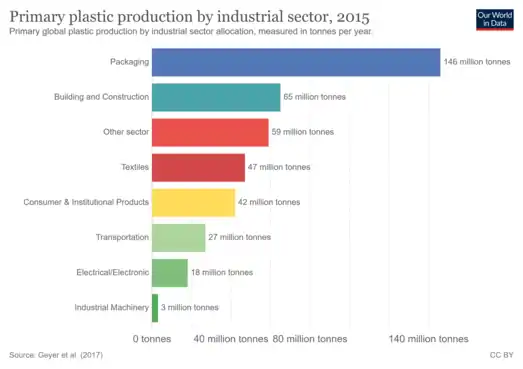
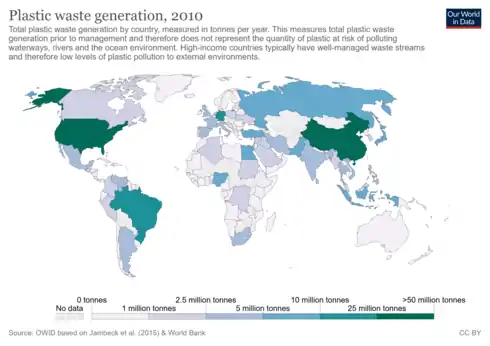
Types of packaging wastes
Glass containers
Bottles and jars for drinks and storing foods or juices are examples of glass containers. It's been estimated by the EPA that 9.1 million tons of glass containers were generated in 2015, or 3.5 percent of municipal solid waste (MSW).[1] About 70 percent of glass consumption is used for containers and packaging purposes.[6] At least 13.2 percent of the production of glass and containers are burned with energy recovery. [1] The amount of glass containers and packaging going into the land fill is about 53 percent.[1]
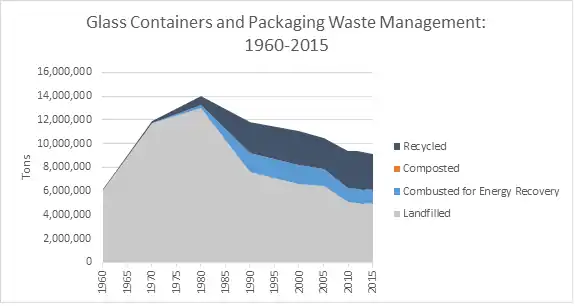
Aluminum containers and packaging
Aluminum container and packaging waste usually comes from cans from any kind of beverages, but foil can also be another that contributes it as well. It's been given that about 25 percent of aluminum is used for packaging purposes.[6] Using the Aluminum Association Data, it has been calculated that at least 1.8 million tons of aluminum packaging were generated in 2015 or 0.8 percent MSW produced.[1] Of those that are produced, only about 670,000 tons of aluminum containers and packaging were recycled, about 54.9 percent.[1] And, the ones that ends up in the land fill is 50.6 percent.[1]
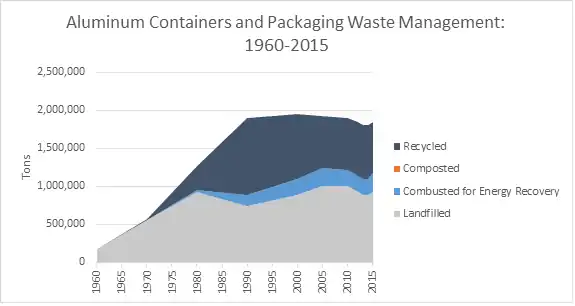
Steel containers and packaging
The production of steel containers and packaging mostly comes in cans and other things like steel barrels. Only about 5 percent of steel use for packaging purposes of the total world of steel consumption which makes it the least amount wasted and the most recycled.[6] It's totaled that 2.2 million tons or 0.9 percent of MSW generated in 2015.[6] While according to the Steel Recycling Institute, an estimate of 1.6 million tons (73 percent) of steel packaging were recycled.[6] Adding on, the steel packaging that were combusted with energy recover was about 5.4 percent and 21.6 percent were land filled.[1]

Paper and paperboard containers and packaging
The most of it being generated, and within the MSW in 2015, was corrugated boxes coming with at least 31.3 million tons (11.3 percent total) produced.[1] However, it also the top most recycled at 28.9 million tons (92.3 percent) boxes being recycled in 2015.[1]
Later on, they are then combusted which makes 0.5 million tons and landfills received 1.9 million tons.[1] Other than corrugated boxes, cartons, bags, sacks, wrapping papers, and other boxes used for shoes or cosmetics are other examples of paper and paperboard containers and packaging. The total amount of MSW generated for paper and paperboard containers and packaging was 39.9 million tons or 15.1 percent in 2015. Although, the recycled rate is about 78.2 percent and 4.3 percent of small proportions were combusted with energy recovery and 17.6 percent in landfill.
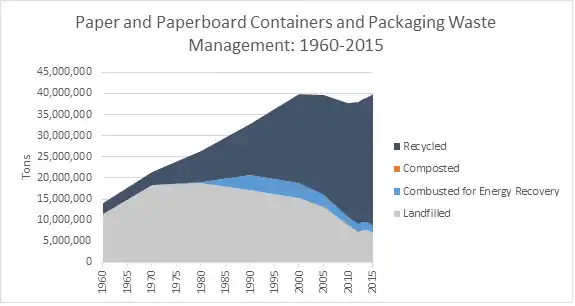
Wood packaging
Wood packaging is anything that is made out of wood used for packaging purposes (e.g. wood crates, wood chips, boards, and planks). Wood packaging is still highly use in today's world for transporting goods. According to EPA's data that were borrowed from the Virginia Polytechnic Institute and the United States Department of Agriculture's Forest Service Southern Research Station, 9.8 million tons (3.7 percent of total MSW) of wood packaging were made in production in 2015.[1] Also, in 2015, the amount that was recycled 2.7 million tons.[1] Moreover, its estimated that 14.3 percent of the wood containers and packaging waste generated was combusted with energy recovery, while the 58.6 percent went to the land filled.

Plastic containers and packaging
Plastic containers and packaging can be found in plastic bottles, supermarket bags, milk and water jugs, and more. EPA used data from the American Chemistry Council to estimate that 14.7 million tons (5.5 percent of MSW generation) of plastic containers and packaging were created in 2015.[1] The overall amount that is recycled is about 2.2 million tons (14.6 percent).[1] In addition, 16.8 percent were combusted with energy recover and 68.6 percent went straight into the land fill.[1] Most of the plastics are made from polyethylene terephthalate (PET), high-density polyethylene (HDPE), low-density polyethylene (LDPE), polyvinyl chloride (PVC), polystyrene (PS), polypropylene (PP) and other resins.[1] That being said, the recycling rate for PET bottles and jars was 29.9 percent (890,000 tons) and the recycling of HDPE water and milk jugs was 30.3 percent (230,000 tons).[1]
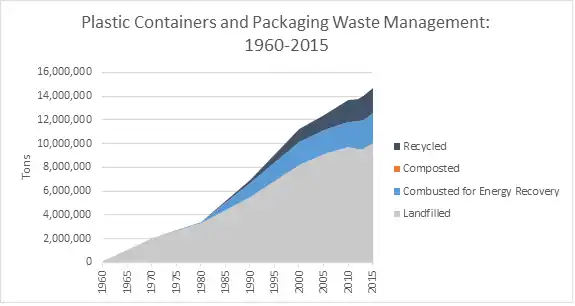
Role of packaging waste in pollution
Litter
Litter, a horrific sight in water systems and public places, mostly consists of packaging waste. Besides the disfigurement of the landscape, it also poses a health hazard for various life forms.[6] Packaging materials such as glass and plastic bottles are the main constituents of litter.[6] It has a huge impact on the marine environment as well, when animals are caught in or accidentally consume plastic packaging.
Air pollution
The production of packaging material is the main source of the air pollution that is being spread globally. Some emissions comes from accidental fires or activities that includes incineration of packaging waste that releases vinyl chloride, CFC, and hexane.[6] For a more direct course, emissions can originate in land fill sites which could release CO2 and methane.[6] Most CO2 comes from steel and glass packaging manufacturing.[6]
Water pollution
Packaging waste can come from land based or marine sources. The current location that has the makes up the large of amount of water pollution is the Great Pacific Garbage Patch located at West Coast of North America to Japan.[2][3] Marine sources such as rivers that caught packaging materials and are eventually be lead to the oceans. In global standards, about 80 percent of packaging waste in ocean comes from land based sources and 20 percent comes from marine sources.[2] The 20 percent of packaging waste that comes from marine sources comes from the rivers of China starting from least to greatest contributors, the Hanjiang, Zhujiang, Dong, Huangpu, Xi, and Yangtze river.[2] All other marine sources comes from rivers of Africa and Southeast Asia.[2]
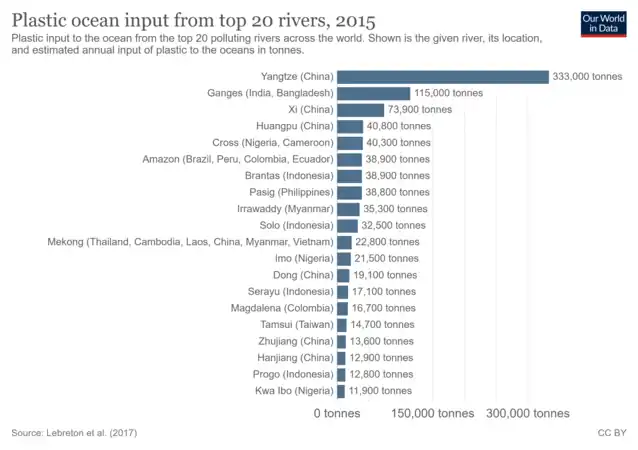
Impacts on marine species and wildlife species
Most marine species and wildlife species suffer from the following:
- Entanglement: At least 344 species are entangled by packaging waste, specifically the ones that are plastics.[2] Most of the victims are marine species like whales, seabirds, turtles, and fish.[2][3]
- Ingestion: 233 marine species are recorded that had consumed plastic packaging waste of either unintentionally, intentionally, or indirectly.[2] Again, the following victims would be whales, fish, mammals, seabirds, and turtles.[2][3] The effects of eating plastic packaging waste could lead to greatly reduced stomach capacity, leading to poor appetite and false sense of satiation.[2] Whats worse is that the size of the ingested material is ultimately limited by the size of the organism.[2] For example, microplastics consumed by planktons and fishes can consume cigarettes boxes.[2][3] Plastic can also obstruct or perforate the gut, cause ulcerative lesions, or gastric rupture.[2][3] This can ultimately lead to death.
- Interaction: Animals contacting with packaging waste includes collisions, obstructions, abrasions or use as substrate.[2]
Impacts on human health
Bisphenol A (BPA), styrene and benzene can be found in certain packaging waste.[3][5] BPA can affect the hearts of women, permanently damage the DNA of mice, and appear to be entering the human body from a variety of unknown sources.[3] Studies from Journal of American Association shows that higher bisphenol A levels were significantly associated with heart diseases, diabetes, and abnormally high levels of certain liver enzymes.[3] Toxins such as these are found within our food chains. When fish or plankton consume microplastics, it can also enter our food chain.[2][5] Microplastics was also found in common table salt and in both tap and bottled water.[5] Microplastics are dangerous as the toxins can affect the human body's nervous, respiratory, and reproductive system.[2][3][6]
Actions to reduce packaging wastes
Waste management system improvements
Promotion of eco-friendly alternatives
Governments working with industries could support the development and promotion of sustainable alternatives in order to phase out single-use plastics progressively.[5] If governments were to introduce economic incentives, supporting projects which upscale or recycle single-use items and stimulating the creation of micro-enterprises, they could contribute to the uptake of eco-friendly alternatives to single-use plastics.[5]
Social awareness and education
Social awareness and education is also one of the ways to help contribute to issues similar to helping reducing packaging waste. Using the media gives quick access for the individuals or groups to spread information and awareness in regarding to letting the public know what is going on in the world and ways that others can contribute to assist in fixing problems of packaging wastes. Schools are also good for spreading the education with factual knowledge, possible outcomes for the increase of packaging waste, and provide ways to get individuals to give a helping hand in keeping our planet clean. Public awareness strategies can include a wide range of activities designed to persuade and educate.[5] These strategies may focus not only on the reuse and recycling of resources, but also on encouraging responsible use and minimization of waste generation and litter.[5]
See also
- Plastic waste
- Waste & Resources Action Programme
- Packaging Recovery Note
- Packaging and packaging waste directive
- Producer Responsibility Obligations (Packaging Waste) Regulations 2007
- Reusable packaging
- Sustainable packaging
- Fast food
- Pollution prevention
- Waste minimization
- Circular economy
References
- US EPA, OLEM (September 7, 2017). "Containers and Packaging: Product-Specific Data". US EPA. Retrieved October 29, 2019.
- Ritchie, Hannah; Roser, Max (September 1, 2018). "Plastic Pollution". Our World in Data. Retrieved October 29, 2019.
- Guren, Claire Le (November 2009). "Plastic Pollution". Coastal Care. Retrieved October 30, 2019.
- https://www.deutschland.de/en/topic/life/packaging-free-shops-in-germany-this-is-how-the-system-works
- Giacovelli, Claudia (2018). Single-use plastics, a roadmap for sustainability. Nairobi, Kenya: United Nations Environment Programme. ISBN 9789280737059. OCLC 1096282673.
- Pongrácz, Eva (March 23, 2007), "The Environmental Impacts of Packaging", Environmentally Conscious Materials and Chemicals Processing, pp. 237–278, ISBN 9780470168219, retrieved October 30, 2019
